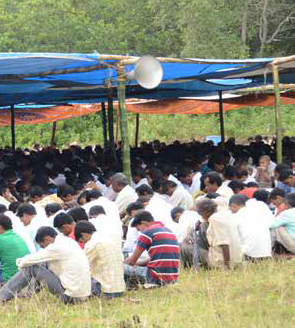
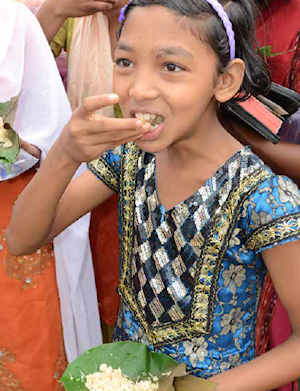
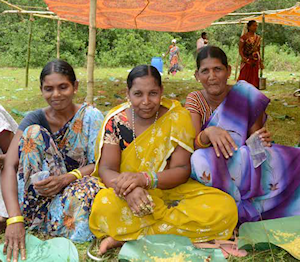
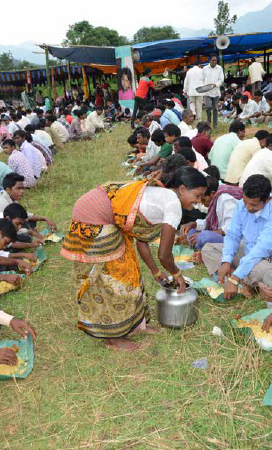
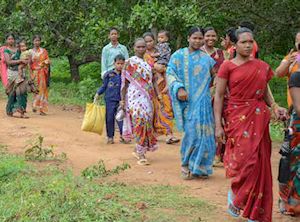
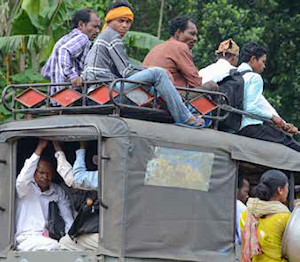
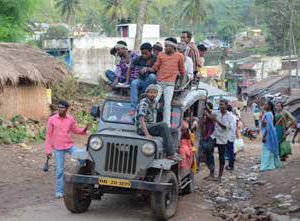
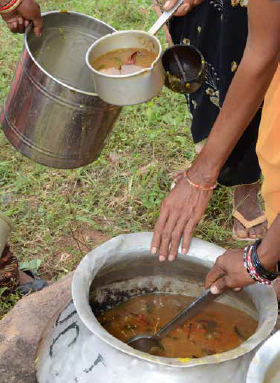
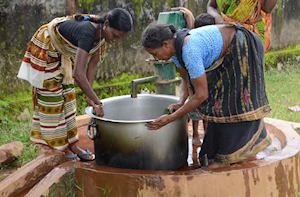
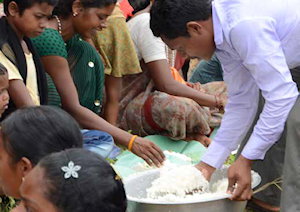
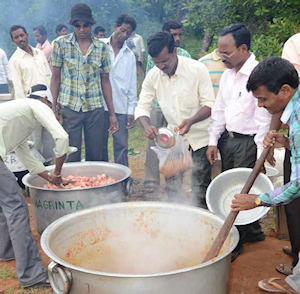
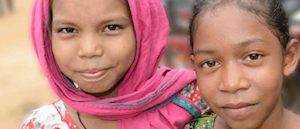
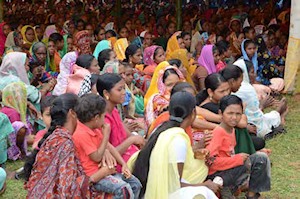
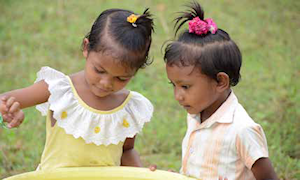
Feeding the Soura Tribe
Thousands participate in the feeding program
Mother Teresa Children's Foundation (MTCF) sponsored a mass feeding and gathering for the Soura tribal people in the state of Orissa.
An estimated 10,000 Soura men, women and children congregated. The feeding was staged in adjacent large fields in Taraba village, located about six kilometers from the MTCF‑supported Soura girls' hostel.
Members of the Soura tribe came from 821 villages to attend the gathering, some traveling distances of up to 200 kilometers. Many people reported starting their journey at 2 am the previous morning. Crammed buses and open bed trucks stacked with people begin arriving around 8 am on the morning of the gathering. By 10 AM, constant streams of people walked down dirt roads leading to the event area.
"The purpose of the gathering is greater than just food," said MTCF president Dr. Sajan George Kavinkalath. "The Soura tribe needs to know that someone cares about them. Despite their daily struggles, they still live multi-dimensional lives; they don't just suffer from hunger and poverty. Families laugh, cry, celebrate, grieve and hope, just like the rest of us."
About one hundred families volunteer to help cook the food and serve their fellow tribe members.
On the day of the event, those who arrive before 9 AM receive breakfast on large banana leaves plucked from nearby trees. Volunteers serve porridge and wheat cake onto the big, green leaves. The tribal people scoop it up and eat with their hands.
By mid-morning, the crowd gathers en masse and participates in an organized program that includes group singing and speaking from local tribal leaders. Dr. Sajan George Kavinkalath, president of Mother Teresa Children's Foundation greets the crowd on behalf of MTCF and speaks for about thirty minutes.
A public address system with speakers is utilized so the entire crowd can hear and participate. A portion of the field is also staked with tall tarps to provide protection from the weather, which can be hot, beating sun, or heavy rain, depending on the season.
One of the most notable aspects of the event is the unity and mutual cooperation of those who are being served. Everyone who attends is hungry, yet when food is dispensed the atmosphere is not frenzied.
Several thousand attendees stand patiently in lines to receive breakfast. After the conclusion of the organized program, the crowd of ten thousand breaks into groups and lunch is served efficiently. Men and women split into sections by gender and sit on the ground, legs crossed, in long, horizontal lines. The division occurs quickly and seamlessly.
Volunteers walk the "aisles" between each line and disburse a square piece of green, waxy paper that resembles a real banana leaf; it's the Indian equivalent of a disposable plate. Volunteers carry large pots with ladles.
They dish out the rice, layer on chicken, dal (like a lentil soup) and Sambar, a traditional Indian spicy stew. The estimated number of Soura people fed at each mass event is derived both by visual crowd estimation and the quantity of food served. Volunteers also count the number of green papers distributed at lunch.
In May 2012, MTCF sponsored the first mass feeding of the year in the village of Linga. An estimated 6,000 Soura people attended. In addition to food, MTCF also presented some of the most needy families with cows and goats to assist with daily sustenance, as well as bicycles for some needing daily access to transportation.
About the Tribe
People of the Soura tribe isolate themselves in huts located at high elevations on often inaccessible mountaintops. Huts are hidden in the folds of mountains and reached on foot by negotiating steep, zigzagging paths. The Soura are expert climbers.
Generally, the terrain where they settle is hilly and dense. In most cases, it is logistically impossible for the Soura children to walk the distances or negotiate the terrain required to reach schools in the nearest village at lower elevations.
The childhood homes where the MTCF Soura girls lived before coming to the compound in Gumma are difficult to imagine for anyone who has enjoyed the privilege and services typical of a first world country. Their families build huts, usually rectangular with one small main door, using bamboo and mud. Family livestock can often be found living within the same cramped space. Most Soura survive with little food, no electricity, no running water, no developed sanitation or access to transportation.
Local people sit along the roads with hammers and chisels and chip away at the large rocks to create gravel for a new road surface. They earn about 100-200 rupees (The equivalent of 50 cents to one US Dollar) per day.
Both men and women squat and work continuously, without protection from pouring rain or beating sun. The job is tedious and physically demanding. They move the large boulders by hand, build fire pits to heat the rocks, making them easier to break, then chisel broken chunks into smaller pieces.
In addition to physical labor, many of the Soura also work tending and herding livestock and animals or laboring in fields. At the lower elevations, rice paddies are plentiful. All are low wage earners and poverty is rampant. They have their own dialect and isolate themselves from other tribes.
Bore Well
In addition to the periodic mass feedings, Mother Teresa Children's Foundation installed a bore well in the Soura village of Serango.
The first attempt at the bore well in Serango proved unsuccessful. Work commenced in early July 2012. Construction workers arrived with equipment and drilled down 275 feet before abandoning the location.
The failed attempt cost about $1,000 USD. "It is one of the challenges in digging these wells. You can hire experts and analyze all day long, but you don't know for sure there is water until you drill," said Dr. Sajan George Kavinkalath, MTCF president.
The team selected a second location and began drilling immediately. On July 26, 2012, they had water. All construction was complete in August of 2012, including the concrete surround that protects the motor and electrical components. Directly adjacent to the bore well location is a waterspout for individual use where villagers come and collect water in buckets.
Prior to the MTCF bore well, the Soura people in this area used an open water well that provided some water during the rainy season, but would dry up in the summer months.
The water from the open well, when available, is dirty and is similar to the color of tea; Water has to be boiled over open fires to purify it. Because water was in such short supply, those living in the village bathed in the nearby spring—the same water used by animals and livestock.
The local people consider the new MTCF bore well a miracle. According to MTCF President Dr. Sajan George Kavinkalath, it is has the best water yeild of any well he has seen. The new well can support the water needs of up to 1,500 people daily.